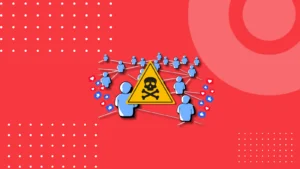Navigating Through Social Media Toxicity

In today’s digital age, social media has become an integral part of our lives, transforming the way we communicate, share information, and interact with brands. However, along with its many benefits, social media also presents challenges, including the potential for toxicity and negativity that can impact brands. Toxicity on social media can arise in various forms, such as negative comments, trolls, fake news, and online harassment, and can quickly escalate, posing risks to a brand’s reputation and bottom line. In this blog, we will explore strategies for brands to navigate social media toxicity and protect their reputation.
Set clear social media guidelines:
Establishing clear guidelines for social media usage and engagement is essential for brands. These guidelines should outline what is considered acceptable behavior on social media, and what will not be tolerated. For example, guidelines can specify that hate speech, discriminatory language, and personal attacks will not be tolerated, and any such content will be removed. Brands should also have a process in place for dealing with negative comments or feedback, and ensure that all social media managers are trained to handle such situations professionally and with empathy.
Monitor social media channels:
Regularly monitoring social media channels is crucial for identifying potential issues early and addressing them promptly. Brands should invest in social media monitoring tools to track mentions, comments, and conversations about their brand. This allows brands to quickly detect any toxic content, such as hate speech or false information, and take appropriate action, such as removing or reporting it. Monitoring also provides an opportunity to identify trends, sentiment, and feedback from customers, which can be used to improve products or services.
Respond promptly and authentically:
When brands encounter toxicity on social media, it is crucial to respond promptly and authentically. Ignoring or deleting comments without addressing the issue can often exacerbate the situation. Brands should respond with empathy, acknowledging the concern or feedback, and offering a solution or clarification, if appropriate. It is important to avoid engaging in arguments or getting defensive, as this can further escalate the situation. Responding in a professional and empathetic manner can help defuse toxic situations and show the brand’s commitment to addressing customer concerns.
Build a positive online community:
Brands can create a positive online community by fostering a culture of inclusivity, respect, and engagement on their social media channels. This can be achieved by posting positive and informative content, encouraging user-generated content, and promoting meaningful conversations. Brands can also establish community guidelines that promote respectful and constructive discussions and encourage users to report any toxic behavior. By creating a positive online community, brands can proactively prevent toxicity and create a safe space for their audience to engage.
Fact-check and address misinformation:
Misinformation and fake news can spread rapidly on social media, and brands need to be vigilant in fact-checking and addressing any false information related to their brand. Brands should have a strategy in place to verify information before sharing it on their social media channels and should be prepared to correct any misinformation that may arise. Brands can also work with trusted sources or experts to provide accurate information to counteract false claims.
Take legal action when necessary:
In some cases, social media toxicity may cross the line into harassment, defamation, or other illegal activities. In such situations, brands should not hesitate to take legal action to protect their reputation and rights. It is essential to work with legal professionals who specialize in social media law and understand the complexities of navigating legal issues in the digital world.
Stay true to your brand’s values:
Finally, it’s essential to stay true to your brand’s values. Don’t compromise your values to appease a vocal minority on social media. Instead, stick to your brand’s message and values, and use social media to amplify your message and connect with your customers.
In conclusion, navigating through social media toxicity is crucial for any brand that wants to maintain a positive online reputation. By monitoring your social media channels regularly, developing a crisis communication plan, responding appropriately, creating a positive online community, avoiding controversial topics, and staying true to your brand’s values, you can effectively navigate through social media toxicity and build a strong and positive online presence.





